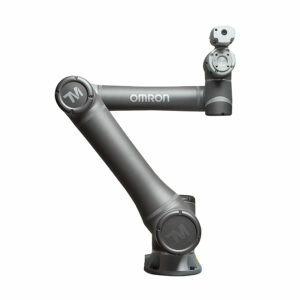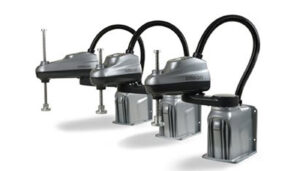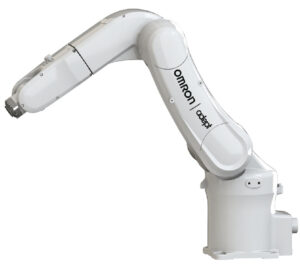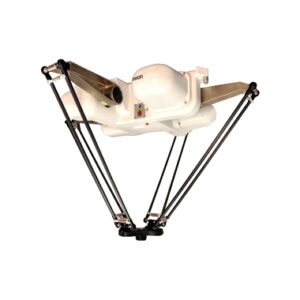 There are many benefits to using cobots production or assembly lines. Collaborative robots can make automation a possibility for businesses of every size and product type. And they are more accessible and affordable for smaller businesses. You don’t need millions in capital or a massive production to justify the investment. You don’t have to have a programming background to set up and program a collaborative robot. They can easily be set up and programmed by operators with no previous experience. Omron’s TM Cobot Series is programmed using TMflow, a user-friendly, flow-based robot editing software that allows users to easily design cobot workflow. It is a simple, click-and-drag program which means programming knowledge is not a requirement for people to use it. Operators with zero programming or IT experience can program a project in just five minutes.
There are many benefits to using cobots production or assembly lines. Collaborative robots can make automation a possibility for businesses of every size and product type. And they are more accessible and affordable for smaller businesses. You don’t need millions in capital or a massive production to justify the investment. You don’t have to have a programming background to set up and program a collaborative robot. They can easily be set up and programmed by operators with no previous experience. Omron’s TM Cobot Series is programmed using TMflow, a user-friendly, flow-based robot editing software that allows users to easily design cobot workflow. It is a simple, click-and-drag program which means programming knowledge is not a requirement for people to use it. Operators with zero programming or IT experience can program a project in just five minutes.
Cobots are used in a wide variety of common applications in many industries such as pick and place of both in-process and finished goods, assembly operations, machine tending and even the inspection of products. With improved productivity and efficiency, cobot automation improves productivity and efficiency and reduces wasted resources, like manpower and raw materials. Cobots are also an ideal solution for solving labor shortages and social distancing challenges. They can work 24 hours a day, freeing up workers to learn new skills and focus on other areas of the operation.
 SCARA is an acronym for Selective Compliance Assembly Robot Arm or Selective Compliance Articulated Robot Arm. SCARA robots consist of four independent motion axes in a configuration that enables the robot to position its tooling in terms of X, Y, Z, and Theta (or rotation around the Z coordinate) within the robot’s work area. High-performance four-axis SCARA robots are
SCARA is an acronym for Selective Compliance Assembly Robot Arm or Selective Compliance Articulated Robot Arm. SCARA robots consist of four independent motion axes in a configuration that enables the robot to position its tooling in terms of X, Y, Z, and Theta (or rotation around the Z coordinate) within the robot’s work area. High-performance four-axis SCARA robots are
ideal for mechanical assembly, material handling, packaging, machine tending, and screw driving. And they can be floor or ceiling mounted. SCARA robots are known for their fast motion capabilities while also providing more accurate and rigid positioning than that of a parallel robot.
SCARA robots are used in applications where parts need to be moved from one position to another that do not require any additional articulation aside from being rotated. Their speed enables them to be good choices for simple material handling applications such as pick and place as well as packaging. Their high level of accuracy and rigidity also make them well suited for basic assembly processes and dispensing. Omron’s newest addition to their SCARA line is the i4L and i4H SCARA robots, compact robots that feature high inertia and high duty ratings which are uncommon to lighter duty SCARA robots. Combined with a 5kg payload and a high degree of repeatability, the i4L can tackle more challenging processes with ease and without fear of unexpected faults.
 Articulated robots are robots that have 5 axes or more and are typically used in applications that require a higher degree of robot tool movement, or articulation, to execute the process. A six-axis robot, like Omron’s Adept Viper, is used for applications that require fast and precise automation.For example, you would want to use an articulated robot if you had a process that required a part to be flipped over while the robot was still holding on to it or in a sealing application where the dispense tip needed to be positioned in many different angles as the robot executed its motion path.
Articulated robots are robots that have 5 axes or more and are typically used in applications that require a higher degree of robot tool movement, or articulation, to execute the process. A six-axis robot, like Omron’s Adept Viper, is used for applications that require fast and precise automation.For example, you would want to use an articulated robot if you had a process that required a part to be flipped over while the robot was still holding on to it or in a sealing application where the dispense tip needed to be positioned in many different angles as the robot executed its motion path.
 Because of their ability to move very quickly, parallel robots are used in applications that often involve very high speeds that do not require high levels of positional accuracy, such as the picking and placing of items moving on conveyor belts. Parallel robots are one of the most popular types of robots in food and beverage, pharmaceutical and healthcare, packaging, automotive and semiconductor. They are ideal for applications such as primary and secondary packaging, and measuring, inspection and testing. The Hornet and Quattro are parallel robots ideal for use in the food and beverage, pharmaceutical, and healthcare industries. The Quattro is a four-axis parallel robot with a high payload capacity that achieves high speed and high precision. The servo amplifier and controller are fully embedded into the robot, reducing wiring and saving valuable floor space.
Because of their ability to move very quickly, parallel robots are used in applications that often involve very high speeds that do not require high levels of positional accuracy, such as the picking and placing of items moving on conveyor belts. Parallel robots are one of the most popular types of robots in food and beverage, pharmaceutical and healthcare, packaging, automotive and semiconductor. They are ideal for applications such as primary and secondary packaging, and measuring, inspection and testing. The Hornet and Quattro are parallel robots ideal for use in the food and beverage, pharmaceutical, and healthcare industries. The Quattro is a four-axis parallel robot with a high payload capacity that achieves high speed and high precision. The servo amplifier and controller are fully embedded into the robot, reducing wiring and saving valuable floor space.
 Mobile robots also known as AMRs (Autonomous Mobile Robots) are used in many industries to move parts or materials from one location to another. Unlike fixed material transport systems like conveyor systems, AMRs are able to drive around a facility unbound to a fixed route. Their wireless communications to the facility and onboard navigation systems enable them to receive commands on where to go and are able to navigate to the requested location without being programmed to do so and can even find an alternate path when an obstacle is encountered. Common uses for mobile robots are the movement of pallets, part totes, work in process material transport and mixed order fulfillment. More recently, specialty applications have emerged in the non industrial sector and include the delivery of items to guests in a hotel, inventory inspection in commercial stores, and even disinfection of public spaces with special UV light.
Mobile robots also known as AMRs (Autonomous Mobile Robots) are used in many industries to move parts or materials from one location to another. Unlike fixed material transport systems like conveyor systems, AMRs are able to drive around a facility unbound to a fixed route. Their wireless communications to the facility and onboard navigation systems enable them to receive commands on where to go and are able to navigate to the requested location without being programmed to do so and can even find an alternate path when an obstacle is encountered. Common uses for mobile robots are the movement of pallets, part totes, work in process material transport and mixed order fulfillment. More recently, specialty applications have emerged in the non industrial sector and include the delivery of items to guests in a hotel, inventory inspection in commercial stores, and even disinfection of public spaces with special UV light.
If you have questions about robots or need help deciding if they’re right for your business, contact an MSI TEC Robotics Engineer.
Be the first to learn about classes, training, webinars, products news and more.
We use only necessary cookies on this website to provide the best user experience and customer service.